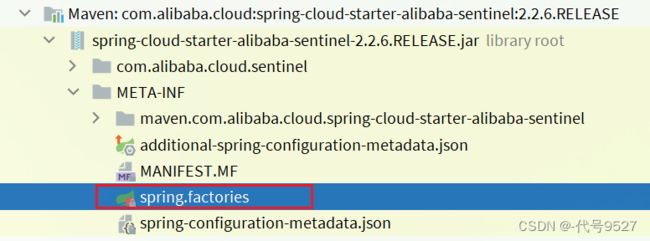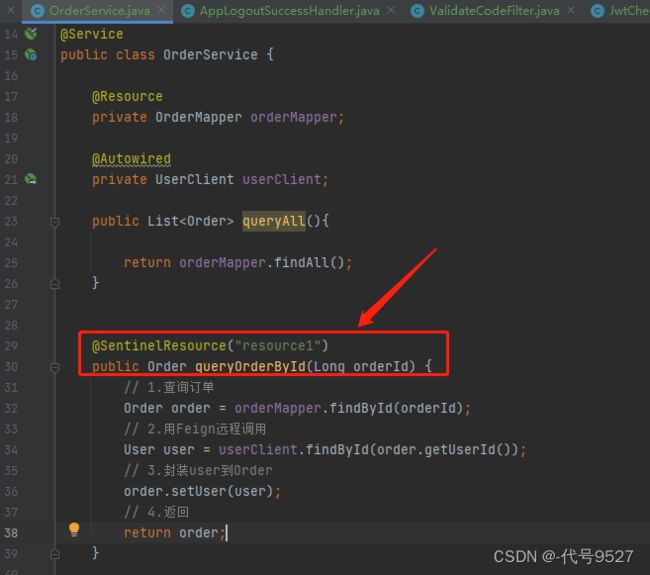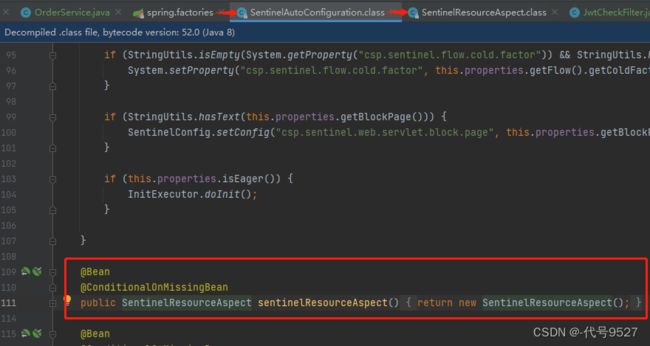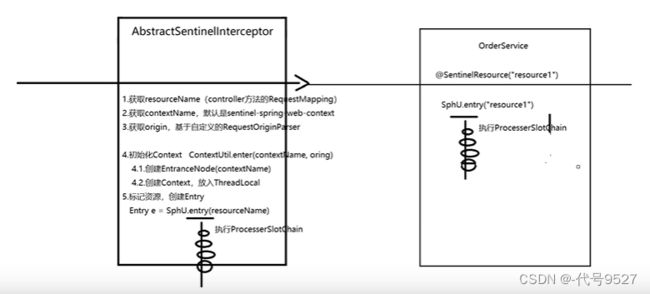【Sentinel】核心API-Entry与Context
文章目录
- 一、Entry
-
- 1、Entry的声明
- 2、使用API自定义资源
- 3、基于@SentinelResource注解标记资源
- 二、Context
-
- 1、Context介绍
- 2、Context的初始化
- 3、AbstractSentinelInterceptor
- 4、ContextUtil
一、Entry
1、Entry的声明
默认情况下,Sentinel会将controller中的方法作为被保护资源,那么问题来了,我们该如何将自己的一段代码标记为一个Sentinel的资源呢?
Sentinel中的资源用Entry来表示。
声明Entry的API示例:(try后面直接加括号写上对应的资源,就不用自己再加finally语句去关闭了,即try-with-resource)
// 资源名可使用任意有业务语义的字符串,比如方法名、接口名或其它可唯一标识的字符串。
try (Entry entry = SphU.entry("resourceName")) {
// 被保护的业务逻辑
// 你想做的操作,比如异常次数+1、调用次数+1
// do something here...
} catch (BlockException ex) {
// 业务代码抛的异常+限流的异常
// 资源访问阻止,被限流或被降级
// 在此处进行相应的处理操作
}
try-with-resource的写法需要注意:
特别地,若 entry 的时候传入了热点参数,那么 exit 的时候也一定要带上对应的参数(exit(count, args)),否则可能会有统计错误。这个时候不能使用 try-with-resources 的方式。另外通过 Tracer.trace(ex) 来统计异常信息时,由于 try-with-resources 语法中 catch 调用顺序的问题,会导致无法正确统计异常数,因此统计异常信息时也不能在 try-with-resources 的 catch 块中调用 Tracer.trace(ex)。
不用try-with-resource,手动exit的写法:
Entry entry = null;
// 务必保证 finally 会被执行
try {
// 资源名可使用任意有业务语义的字符串,注意数目不能太多(超过 1K),超出几千请作为参数传入而不要直接作为资源名
// EntryType 代表流量类型(inbound/outbound),其中系统规则只对 IN 类型的埋点生效
entry = SphU.entry("自定义资源名");
// 被保护的业务逻辑
// do something...
} catch (BlockException ex) {
// 资源访问阻止,被限流或被降级
// 进行相应的处理操作
} catch (Exception ex) {
// 若需要配置降级规则,需要通过这种方式记录业务异常
Tracer.traceEntry(ex, entry);
} finally {
// 务必保证 exit,务必保证每个 entry 与 exit 配对
if (entry != null) {
entry.exit();
}
}
关于SphU.entry()方法的参数:

注意:SphU.entry(xxx) 需要与 entry.exit() 方法成对出现,匹配调用,否则会导致调用链记录异常,抛出 ErrorEntryFreeException 异常。常见的错误:
1、自定义埋点只调用 SphU.entry(),没有调用 entry.exit()
2、顺序错误,比如:entry1 -> entry2 -> exit1 -> exit2,应该为 entry1 -> entry2 -> exit2 -> exit1
2、使用API自定义资源
在demo工程的order-service服务中,将OrderService的queryOrderById()方法标记为一个资源:queryOrderById()方法未修改前:
- 首先处理下依赖与配置
<dependency>
<groupId>com.alibaba.cloudgroupId>
<artifactId>spring-cloud-starter-alibaba-sentinelartifactId>
dependency>
spring:
cloud:
sentinel:
transport:
dashboard: localhost:8090 # 这里我的sentinel用了8089的端口
- 修改OrderService类的queryOrderById方法,创建Entry资源,将要保护的一段代码放入try语句来做为一个资源:
public Order queryOrderById(Long orderId) {
// 创建Entry,标记资源,资源名为resource1
try (Entry entry = SphU.entry("resource1")) {
// 1.查询订单
Order order = orderMapper.findById(orderId);
// 2.查询用户,基于Feign的远程调用
User user = userClient.findById(order.getUserId());
// 3.设置
order.setUser(user);
// 4.返回
return order;
}catch (BlockException e){
log.error("被限流或降级", e);
return null;
}
}
重启后可以看到自定义资源成功:

很明显,上面的逻辑在自定义资源时是重复的动作,即创建Entry,再拿个try-catch把要定义的代码包起来。 ⇒ AOP环绕实现,在前面之前try,在之后catch,AOP再兑换成一个注解,这个注解官方已实现,就是@SentinelResource
3、基于@SentinelResource注解标记资源
同样标记Service里的queryOrderById方法:
匹配@SentinelResource注解做AOP环绕增强的源码:
/**
* Aspect for methods with {@link SentinelResource} annotation.
*
* @author Eric Zhao
*/
@Aspect
public class SentinelResourceAspect extends AbstractSentinelAspectSupport {
// 切点是添加了 @SentinelResource注解的类
@Pointcut("@annotation(com.alibaba.csp.sentinel.annotation.SentinelResource)")
public void sentinelResourceAnnotationPointcut() {
}
// 环绕增强
@Around("sentinelResourceAnnotationPointcut()")
public Object invokeResourceWithSentinel(ProceedingJoinPoint pjp) throws Throwable {
// 获取受保护的方法
Method originMethod = resolveMethod(pjp);
// 获取 @SentinelResource注解
SentinelResource annotation = originMethod.getAnnotation(SentinelResource.class);
if (annotation == null) {
// Should not go through here.
throw new IllegalStateException("Wrong state for SentinelResource annotation");
}
// 获取注解上的资源名称
String resourceName = getResourceName(annotation.value(), originMethod);
EntryType entryType = annotation.entryType();
int resourceType = annotation.resourceType();
Entry entry = null;
try {
// 创建资源 Entry
entry = SphU.entry(resourceName, resourceType, entryType, pjp.getArgs());
// 执行受保护的方法
Object result = pjp.proceed();
return result;
} catch (BlockException ex) {
return handleBlockException(pjp, annotation, ex);
} catch (Throwable ex) {
Class<? extends Throwable>[] exceptionsToIgnore = annotation.exceptionsToIgnore();
// The ignore list will be checked first.
if (exceptionsToIgnore.length > 0 && exceptionBelongsTo(ex, exceptionsToIgnore)) {
throw ex;
}
if (exceptionBelongsTo(ex, annotation.exceptionsToTrace())) {
traceException(ex);
return handleFallback(pjp, annotation, ex);
}
// No fallback function can handle the exception, so throw it out.
throw ex;
} finally {
if (entry != null) {
entry.exit(1, pjp.getArgs());
}
}
}
}
简单来说,@SentinelResource注解就是一个标记,而Sentinel基于AOP思想,对被标记的方法做环绕增强,完成资源(Entry)的创建。
二、Context

如图,除了簇点链路中的controller方法,以及我自定义的资源,还有一个默认的入口节点:sentinel_spring_web_context,它是一个EntranceNode类型的节点,这个节点是在初始化Context的时候由Sentinel帮我们创建的。
1、Context介绍
- Context 代表调用链路上下文,贯穿一次调用链路中的所有资源(
Entry),基于ThreadLocal。 - Context 维护着入口节点(
entranceNode)、本次调用链路的 curNode(当前资源节点)、调用来源(origin)等信息。 - 后续的Slot都可以通过Context拿到DefaultNode或者ClusterNode,从而获取统计数据,完成规则判断
- Context初始化的过程中,会创建EntranceNode,contextName就是EntranceNode的名称
创建Context的API为:
// 创建context,包含两个参数:context名称、 来源名称
ContextUtil.enter("contextName", "originName");
2、Context的初始化
查看Sentinel依赖包下的spring.factories:

spring.factories声明需要就是自动装配的配置类:

先看SentinelWebAutoConfiguration这个类:
这个类实现了WebMvcConfigurer,我们知道这个是SpringMVC自定义配置用到的类,可以配置HandlerInterceptor:

可以看到这里泛型中配置了一个SentinelWebInterceptor的拦截器。SentinelWebInterceptor的声明如下:

发现它继承了AbstractSentinelInterceptor这个类,而AbstractSentinelInterceptor最终实现了HandlerInterceptor

HandlerInterceptor拦截器会拦截一切进入controller的方法,执行preHandle前置拦截方法,而Context的初始化就是在这里完成的。
3、AbstractSentinelInterceptor
HandlerInterceptor拦截器会拦截一切进入controller的方法,执行preHandle前置拦截方法,而Context的初始化就是在这里完成的。来看看这个类的preHandle`实现:
@Override
public boolean preHandle(HttpServletRequest request, HttpServletResponse response, Object handler)
throws Exception {
try {
// 获取资源名称,一般是controller方法的@RequestMapping路径,例如/order/{orderId}
String resourceName = getResourceName(request);
if (StringUtil.isEmpty(resourceName)) {
return true;
}
// 从request中获取请求来源,将来做 授权规则 判断时会用
String origin = parseOrigin(request);
// 获取 contextName,默认是sentinel_spring_web_context
String contextName = getContextName(request);
// 创建 Context
ContextUtil.enter(contextName, origin);
// 创建资源,名称就是当前请求的controller方法的映射路径
Entry entry = SphU.entry(resourceName, ResourceTypeConstants.COMMON_WEB, EntryType.IN);
request.setAttribute(baseWebMvcConfig.getRequestAttributeName(), entry);
return true;
} catch (BlockException e) {
try {
handleBlockException(request, response, e);
} finally {
ContextUtil.exit();
}
return false;
}
}
4、ContextUtil
创建Context的方法就是 ContextUtil.enter(contextName, origin); 我们进入entry方法:
public static Context enter(String name, String origin) {
if (Constants.CONTEXT_DEFAULT_NAME.equals(name)) {
throw new ContextNameDefineException(
"The " + Constants.CONTEXT_DEFAULT_NAME + " can't be permit to defined!");
}
return trueEnter(name, origin);
}
进入trueEnter方法:
protected static Context trueEnter(String name, String origin) {
// 尝试获取context
Context context = contextHolder.get();
// 判空
if (context == null) {
// 如果为空,开始初始化
Map<String, DefaultNode> localCacheNameMap = contextNameNodeMap;
// 尝试获取入口节点
DefaultNode node = localCacheNameMap.get(name);
if (node == null) {
LOCK.lock();
try {
node = contextNameNodeMap.get(name);
if (node == null) {
// 入口节点为空,初始化入口节点 EntranceNode
node = new EntranceNode(new StringResourceWrapper(name, EntryType.IN), null);
// 添加入口节点到 ROOT
Constants.ROOT.addChild(node);
// 将入口节点放入缓存
Map<String, DefaultNode> newMap = new HashMap<>(contextNameNodeMap.size() + 1);
newMap.putAll(contextNameNodeMap);
newMap.put(name, node);
contextNameNodeMap = newMap;
}
} finally {
LOCK.unlock();
}
}
// 创建Context,参数为:入口节点 和 contextName
context = new Context(node, name);
// 设置请求来源 origin
context.setOrigin(origin);
// 放入ThreadLocal
contextHolder.set(context);
}
// 返回
return context;
}
画图表示Entry和Context两个核心API完成资源的创建,不管是controller中的资源还是自定义的资源,接下来就是执行ProcessorSlotChain插槽链,关于ProcessorSlotChain的执行,见下篇。




